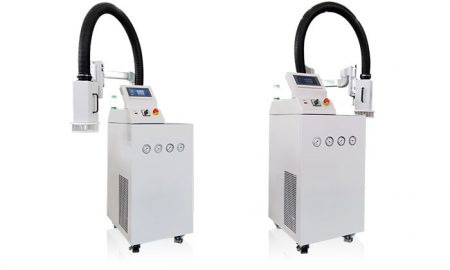Semiconductor Application Temperature Forcing System
Свяжитесь с нами сегодня, чтобы получить идеальное решение для контроля температуры
The semiconductor application temperature forcing system is an instrument that tests the ability of semiconductor devices to withstand impact heat flow in high and low temperature environments. Its main principle is to conduct high-temperature, low-temperature, thermal shock and other tests on semiconductor devices by controlling ambient temperature and heat flow to evaluate their stability and reliability in extreme environments. This instrument is widely used in the fields of semiconductor device R&D, production and quality control.
Application scope of semiconductor application temperature forcing system
Suitable for various types of semiconductor chips, flash memory Flash/EMMC, PCB circuit board IC, optical communications (such as transceiver high and low temperature testing, SFP optical module high and low temperature testing, etc.), electronics industry, etc. for IC characteristic analysis, high and low temperature cycle testing, temperature shock Testing, failure analysis and other reliability tests.
How does semiconductor application temperature forcing system works?
1. The output airflow cover of the testing machine will cover the product to be tested, forming a testing chamber with a relatively closed space. The high-temperature or low-temperature airflow output by the testing machine will cause drastic changes in the surface temperature of the product to be tested, thereby completing the corresponding high and low temperature impact test.
2. A single IC or other component among many components can be isolated and subjected to high and low temperature shocks independently without affecting other surrounding components. Compared with the traditional hot and cold shock test chamber, the temperature change impact rate is faster.

Semiconductor application temperature forcing system is a method to test the thermal stability and heat resistance of materials under high and low temperature conditions. Specific steps are as follows:
1. Prepare the test sample. Select the appropriate material according to actual needs and prepare the sample according to the specified size.
2. Install the test sample. Install the sample into the high and low temperature impact heat flow meter and ensure that the sample is tightly attached to the test bench.
3. Set test parameters. Set parameters such as test temperature, impact time and impact flow according to test requirements.
4. Start testing. Start the high and low temperature impact heat flow meter and let the sample undergo impact testing under the set high and low temperature conditions.
5. Observe the test results. Observe changes on the sample surface, such as cracking, deformation, falling off, etc., and record the test results.
6. Analyze the test results. The thermal stability and heat resistance of the material are analyzed based on the test results, and its reliability in practical applications is evaluated.
It should be noted that the semiconductor application temperature forcing system needs to be carried out in professional laboratories or equipment, and operators need to have corresponding professional knowledge and skills.
Электронная почта: info@lneya.com WeChat ID: +8615251628237 WhatsApp: +86 17851209193

Машина для испытания на ударную вязкость серии AES
Диапазон температурного контроля: -120°C ~ +225°C
 ЛНЕЙЯ
ЛНЕЙЯ
 简体中文
简体中文


















































































